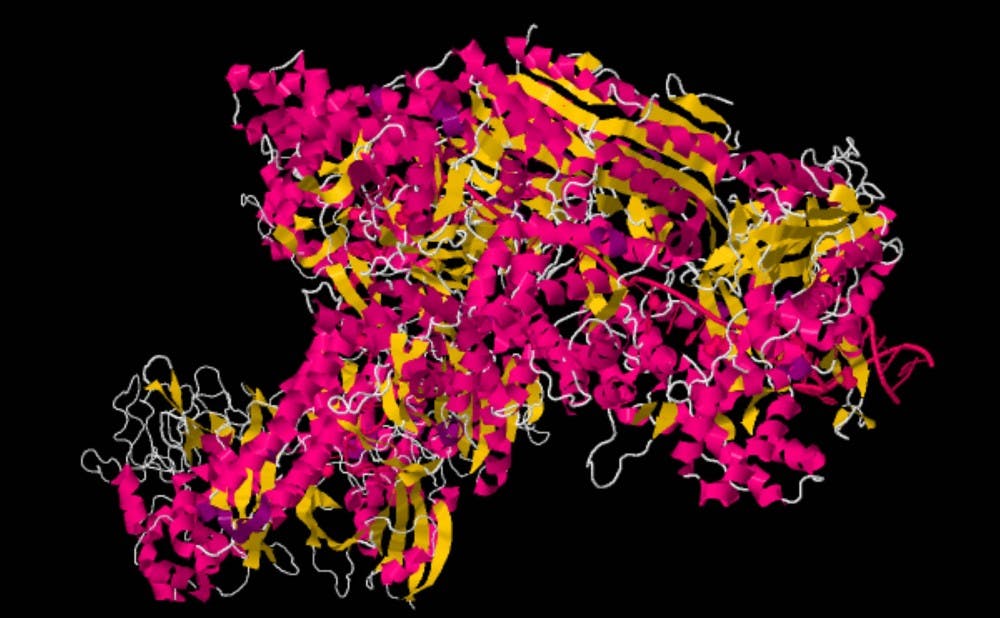A study by Duke researchers focusing on Duchenne muscular dystrophy is the latest advance in CRISPR gene editing technology, which is revolutionizing science’s approach to treating diseases.
In the study, published Dec. 31 in Science, researchers were able to treat DMD in a mouse model by using adeno-associated virus to deliver the CRISPR gene editing system and correct the genetic mutation responsible for the disease. CRISPR—which stands for clustered regularly-interspaced short palindromic repeats—has swept the scientific community in just a few short years, allowing for highly specific modifications to DNA with increasing efficiency. The Duke researchers’ success in using this technique to modify the DNA in a living adult mammal—as opposed to cultured cells in a dish—and to treat the disease is another step forward for CRISPR, one that could have implications for gene therapy in humans.
“There haven’t been many papers characterizing disease-relevant genes in vivo yet, so we’re one of the first to show we can edit a disease-causing gene and restore the phenotype of that disease in vivo,” said Christopher Nelson, first author of the study and postdoctoral research associate in the lab of Charles Gersbach, associate professor of biomedical engineering. “DMD is one of the most common genetic diseases that’s both prevalent and fatal, which makes this paper a significant advance in gene therapy.”
DMD is caused by mutations in the dystrophin gene, resulting in a loss of the corresponding dystrophin protein, muscle degeneration and early fatality. It affects approximately one in 5,000 male births.
Nelson and Gersbach led a team that used CRISPR/Cas-9 technology to delete the mutation causing the disease, resulting in the recovery of the dystrophin protein and some muscle recovery in the mouse model.
CRISPR/Cas-9 was first discovered as a defense mechanism that gives bacteria a form of adaptive immunity against phages and viruses. Particular DNA sequences, or spacers, found in a bacterium’s genome are derived from the DNA sequence of a virus that previously attacked it, allowing the bacterium to recognize that virus when it attacks again. The Cas enzymes are then able cut the DNA of the virus at specific locations, destroying the viral genome.
In 2012, researchers uncovered the CRISPR/Cas-9 system’s potential for targeted genome editing in organisms beyond bacteria.
“When it first came out, it generated tremendous excitement. From our perspective, it’s game-changing technology. It’s cliché to say that, but it really is,” said Daniel Dickinson, a postdoctorate researcher at the University of North Carolina at Chapel Hill who has worked on adapting the CRISPR/Cas-9 technology into a more effective experimental tool. “It allows us to generate changes to the genome in a matter of weeks that we could’ve never before or would’ve taken years. It completely alters the types of experiments we can do.”
In the few years since that major discovery, CRISPR/Cas-9 has become an essential tool in genetic research and has been increasingly explored for potential treatment strategies in a range of diseases, including cancer and AIDS.
“As somebody who’s been a scientist now for 25 years, this is one of the most—if not the most—exciting things I’ve ever witnessed,” said David Sherwood, associate professor of biology, whose lab uses CRISPR/Cas-9 to study developmental processes in the worm C. elegans. “Nobody saw it coming. This technique came from two or three labs that had no interest in human disease—they were just curious about how bacteria defend against virus attack.”
Scientists still face technical and efficiency challenges in using this technique, especially concerning the delivery of the CRISPR/Cas-9 system to diseased cells and the ability to control off-target or unintended effects on the genome. The Duke team was able to successfully package the gene editing technology for DMD into an effective delivery system, which they found in adeno-associated virus.
Ethical concerns have also plagued the development of CRISPR.
When Chinese scientists used CRISPR/Cas-9 to modify a gene in human embryos last year, it led to an international outcry and a debate on what boundaries were needed for the powerful technology.
“We all carry deleterious mutations in our genome. It’s not unreasonable for people to say, let’s nip this in the bud and edit the defective genome in the eggs. That’s a huge ethical dilemma,” Sherwood said.
Gene editing in human embryos is considered unethical by many, though research on gene editing in human patients continues. The distinction, Sherwood explained, is that modifications to the genome in an embryo would be passed along to offspring for generations to come, with potentially dangerous effects.
“In correcting disease, it’s not feasible or ethical to edit embryos,” Nelson added. “Even if it was ethical, it would still be unfeasible, but correcting the adults or young children who have presented with the disease is a much better approach.”
Despite technical limitations and ethical questions, the scientific community seems to agree on the importance of the CRISPR/Cas-9 system in both basic and translational research today.
“It will and is transforming the landscape for treating human diseases, especially genetic disorders,” Sherwood said. “We’re just on the tip of the iceberg in terms of what it can be used for.”
Get The Chronicle straight to your inbox
Signup for our weekly newsletter. Cancel at any time.

